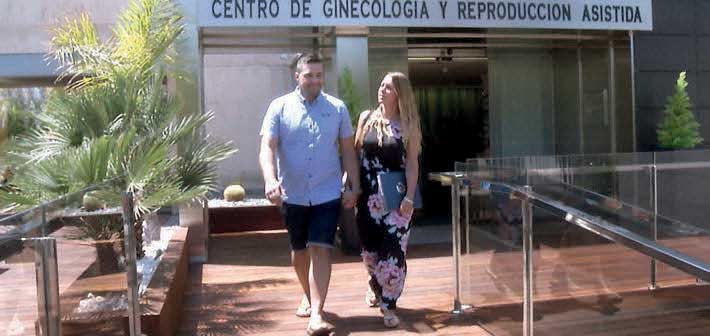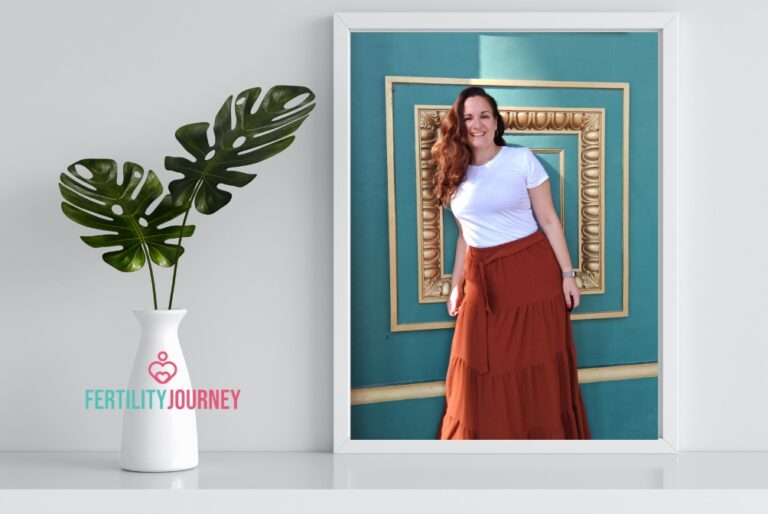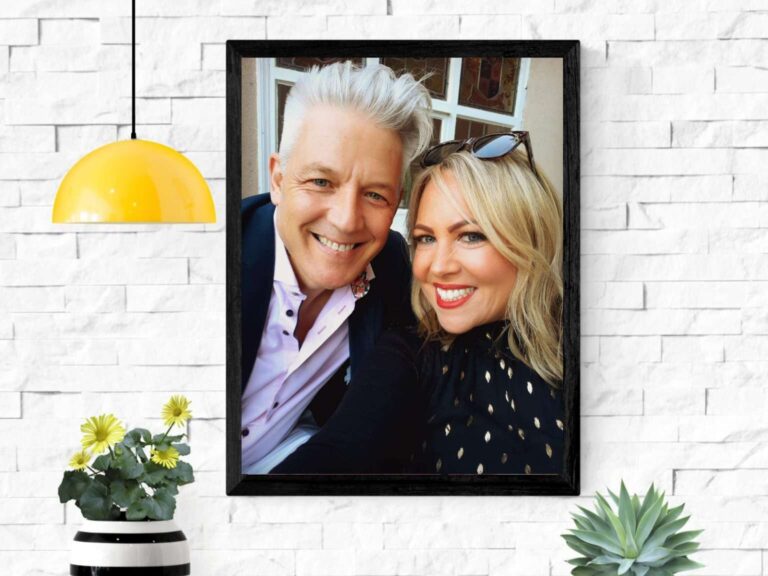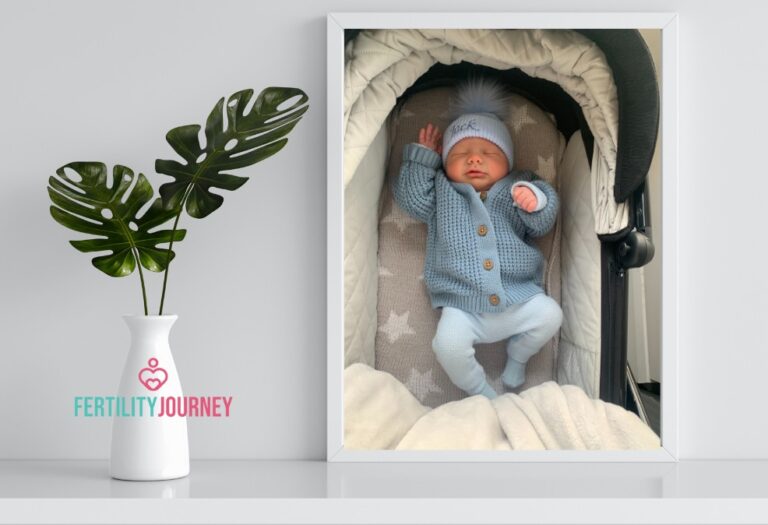We’re excited to share with the readers of Fertility Road Magazine how the journey to parenthood is unfolding for our 2017 couple, Kathryn Hobbs and Richard Clement with IVF Spain.
This adorable English couple came to our fertility clinic for their first visit and consultation on the 27th of May. They met with our medical director, Dr. Natalia Szlarb. After reviewing their medical history and finding out more about their struggle to conceive she has been able to create a personalised treatment plan for Kathryn and Richard’s needs.
The story behind their journey to becoming parents and starting a family is difficult and touching. Kathryn is a primary school teacher who has fallen pregnant naturally followed by two miscarriages before coming to us.
Kathryn wanted to become an egg donor in order to be able to help other couples with fertility problems to become parents. She underwent a series of obligatory tests for donors among which was a karyotype.
The karyotype revealed that Kathryn had a balanced translocation. For this reason, she was unable to be a possible donor, but she was also told that she would not be able to achieve and sustain a pregnancy by natural means with her own eggs even with the help of a ‘mere’ IVF. This information delivered a hard blow to this couple but it also helps to establish a true diagnosis about their case.
Then couple decide to undergo an Embryo banking treatment, which consists of several consecutive ovarian stimulations, egg retrievals and with PGS (Pre-implantation Genetic Screening) for embryos from each cycle. PGS screens the embryos for anomalies in the number of chromosomes (aneuploidy), which account for failure of the embryo before implanting and preventing early miscarriage or malformations at birth. The only aneuploidy that is compatible with life is Down syndrome (which is the manifestation of a trisomy – or three copies instead of the normal two – of chromosome 21). If no anomalies are found in an embryo, it is said that it is euploid.
In total Kathryn underwent 4 IVF cycles of the above-mentioned process. These generated a good number of eggs (37 in total), all of them were successfully fertilised and no male factor was found, despite only two genetically normal (euploid) embryos were obtained.
The embryos were individually transferred to Kathryn on two different occasions, both resulting initially in a pregnancy that would later become a miscarriage.
What is a karyotype?
Our genetic material (genes) are arranged in groups or bundles that we call chromosomes. We have two copies of each. They are coiled up in the nucleus of each of our cells. In summary, genes are arranged in chromosomes, which are arranged in pairs of identical copies in the nuclei of cells.
A karyotype (karyo is the Greek word for ‘nucleus’), is a test designed to determine the number of chromosomes in each cell nucleus (which should be 46 in 23 pairs: 1 pair that determines the sex of the individual – XX for women and XY for men; and 22 pairs of nonsexual or ‘somatic’ chromosomes); and whether there are any missing, extra or rearranged pieces of chromosomal material.
Alterations in the number of chromosomes or in their arrangement can cause different degrees of issues in the carrier.
In the case of Kathryn, the latter was the case, she had a rearrangement of chromosomal material, which is called ‘translocation’.
What does having a translocation imply?
Translocations can be unbalanced or balanced. When a piece of a chromosome detaches from its original location and attaches somewhere else in the set of chromosomes, we call it unbalanced translocation.
When two pieces of chromosomal material exchange positions we call it balanced translocation.
Even though balanced translocations do not usually imply disease for the carrier they can interfere in fertility since the carriers can produce gametes (eggs or sperm cells) with anomalies in their genetic material which are transmitted to any resulting embryos.
The importance of the karyotype in this case lies in the fact that before knowing the result and taking into account Kathryn’s age it was expected that at least 50% of the eggs she generated would be normal. But due to her balanced translocation, this percentage was in fact greatly reduced.
If further analysis would have been performed before continuing with the treatment, the medical team would have been able to establish another approach to their case and maybe Kathryn and Richard would not have had to go through such a costly and long unsuccessful treatment that took a toll on them both financially and emotionally.
Dr. Szlarb: ‘It’s such a pity since Kathryn had two euploid blastocysts, which normally translates into a 70% chance of achieving pregnancy; when as a specialist you see that after 1 or 2 attempts the patient does not become pregnant you must ask yourself the reason for this result and you must perform deeper analyses such as an immunology test, or deeper endometrial studies, which perhaps would have saved Kathryn going through so many IVF cycles’
Finally, and despite all the hardships, Kathryn and Richard haven’t stopped trying to become parents, so they decided to enter the initiative created by
Fertility Road Magazine which awards a complete fertility treatment in a renowned assisted reproduction clinic. This is how they came to find IVF Spain, and thanks to our experience both in the most usual and most complex infertility cases we were able to offer Kathryn and Richard a solution to their problem.
Dr. Szlarb: ‘In England, after each Embryo banking, an embryo was transferred to Kathryn without performing any additional tests of endometrium. At IVF Spain, we take a different approach. We always try to obtain embryos of the maximum possible quality and viability.
Once this is achieved, we perform additional tests to the patient with the aim of finding out the endometrium (womb lining) potential and possible problems.
These tests would be for example immunological tests or the endometrial receptivity array (I-MAP). This way we are able to ensure the highest possible implantation chance. It’s been a really hard journey for Kathryn and Richard as they deal with their fertility issues. After several IVF cycles and miscarriages the consequences for them have been both psychological and emotional.
For this reason, they came to us and chose the egg donation route to finally achieve their dreams of becoming parents.
EGG DONATION IN IVF SPAIN
In Spain, egg donation is anonymous and it is done for altruistic reasons, although the donors do receive a symbolic financial compensation to make up for any possible inconveniences caused by the process.
Moved by this wish to help others, and thanks to the openness in Spain towards egg donation, there are many women keen to donate; which contributes to there being a wide range of available phenotypes.
At IVF Spain we offer an excellent egg donation program that relies on an egg donor bank of more than 500 donors of different nationalities (European, Asian and Middle Eastern, etc.).
By law in Spain the egg donor must resemble the recipient (the patient) as much as possible. With the aim of bringing this resemblance to its highest possible point, IVF Spain developed highly specialised software that was created for our clinic exclusively that helps us find the most adequate set of possible donors for each patient.
Previous to starting the donor’s stimulation we perform numerous medical examinations that include genetic and psychological tests, as established by the Spanish law.
We always try to go a step further to provide our patients the best service and attention.
For this our donor testing includes (among other studies):
Genetic testing (aka Screening Recombine) able to detect up to 213 monogenic diseases.
• Karyotyping, as explained previously.
• Personal and familiar antecedents to rule out risk of transmission of any hereditary diseases.
• Study of diseases: HIV, chlamydia, hepatitis, rubella, toxoplasmosis, cytomegalovirus or syphilis, among others.
•Psychological assessment Kathryn and Richard will come back in August for the embryo transfer.
In order for the embryo to be fresh at the time of the transfer, we will synchronise the stimulations of the donor’s ovaries and Kathryn’s endometrium (womb lining).
By the time the donor stimulation must start we will have found a donor that holds the maximum phenotypic compatibility with both members of the couple.
Kathryn and Richard’s dream of creating their very own family is within reach, and at IVF Spain we will do everything in our power to make it come true.




